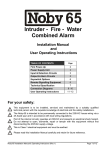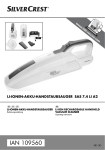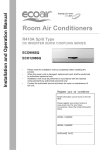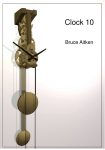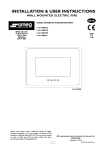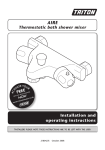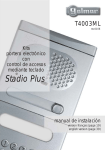Download QUANTA 230W Security Floodlight Instruction manual
Transcript
230W Security Floodlight INSTALLER GUIDE QUANTA V4.0 -10/11 IQ-NALP-180-300-D-GR SECTION ONE GENERAL INFORMATION The unit utilises passive infrared technology to detect heat radiation of moving human bodies. Upon detection, the lamp will illuminate for a user-determined time period. An integral daylight sensor ensures night-only operation. This unit has a dual light level operation. During darkness the lamp will illuminate constantly at a user defined light level until it detects movement, then the unit will switch to full brightness for a user defined time on period. PARTS INCLUDED - Luminaire PIR Sensor unit. - Instruction manual. Please keep safe for future reference. - Accessory Pack. - Tungsten halogen bulb TOOLS & PARTS NEEDED - 3 core flexible rubber cable (1.0mm² or 1.5mm² "H05RN-F") - Electric/hand-held drill & bits. - Terminal or Electrician’s screwdriver - Large slotted/philips screwdriver - Wire cutters Unit is for outdoor use only. Unit must be mounted on a non-flammable surface as a fixed luminaire, and is not suitable for portable use. The unit can get very hot during use. Ensure the unit has cooled before handling. Ensure adequate ventilation space is allowed between the unit and any object above, in front or to either side of the unit. Suggested space is 0.5m above, 0.3m to either side & 1.0m in front. Do not attempt to install during wet weather, if you are suffering from nausea or dizzy spells or on medication with similar side effects. If in any doubt, consult a qualified tradesperson or electrician. SECTION TWO SELECTING THE LOCATION The motion detector has a number of detection zones, at various vertical and horizontal angles as shown (see diagram A). A moving human body needs to cross/enter one of these zones to activate the sensor. The best all-round coverage is achieved with the unit mounted at the optimum height of 2.5m. Careful positioning of the sensor will be required to ensure optimum performance. See diagram A detailing detection range and direction. The sensor is more sensitive to movement ACROSS its field of vision than to movement directly TOWARDS (see diagram B). Therefore position the unit so that the sensor looks ACROSS the likely approach path. Avoid positioning the sensor where there are any sources of heat in the detection area (extractor fans, tumble dryer exhausts etc.) including any other light sources such as other security lighting. Reflective surfaces (ie pools of water or white-painted walls) and overhanging branches may cause false activation under extreme conditions. During extreme weather conditions the motion sensor may exhibit unusual behaviour. This does not indicate a fault with the sensor. Once normal weather conditions return, the sensor will resume normal operation. SECTION THREE INSTALLATION After choosing a suitable location (see previous section) install the unit as follows: The unit is suitable for connection to a 240V 50Hz electricity supply. It is suggested that 3-core round flexible cable of 1mm² gauge is used. An internal switch should be installed to switch the power to the unit ON & OFF. This allows the sensor to be easily switched off when not required or for maintenance purposes. Unfasten the clip on the top of the floodlight glass shield. Install the halogen bulb, making sure not to touch the bulb with bare hands. It is suggested that the bulb is handled using a dry cloth. Ensure the bulb is correctly fitted in the lampholder before use. Re-attach the clip to secure the glass shield to the floodlight. Remove the wall plate from the unit by inserting a terminal screwdriver into the slot at the top, See diagram D. Mark the position of the fitting holes. Drill the holes. Insert wallplugs into the holes. BEFORE SECURING THE WALLPLATE TO THE WALL PIERCE & PASS THE CABLE THROUGH THE GROMMET. Attach the wall plate to the wall. See Diagram E CONNECTION Connect the cable to the terminal block on the wallplate as follows (see connection diagram): NEUTRAL (Blue) EARTH (Green/Yellow) LIVE (Brown) N L Ensure that the connections are secure. To reattach the unit to the wall plate line up the two pins at the top of the unit. Push the unit against the wall plate and the unit will 'Click' into place. Ensure that the bottom clip is fully closed to ensure a water proof seal. See Diagram F. SECTION FOUR OPERATION AND TESTING WALK TESTING PROCEDURE The sensor will rotate from left to right. Adjust the sensor to point in the desired direction. See diagram A & H for the different sensor patterns and lens masking. See diagram C & I for the adjustment controls. Set the Time,Dusk and Dim control as follows : TIME - Fully anti-clockwise DUSK - Fully clockwise Dim - Fully anti clockwise The unit will now operate during daytime as well as at night, illuminating the lamp for approx. 5 seconds each time. This allows testing to be carried out to establish the best position for the sensor. Switch on the mains power. The lamp will immediately illuminate as the unit goes through its "warm-up" period. After approximately 1 - 2 minutes the lamp will extinguish. Try to remain outside the detection area during the warm-up period. Walk across the detection area approx 5 metres from the unit. As you cross a detection "zone" the lamp will illuminate. Now stand still until the lamp extinguishes (this should take approx. 5 seconds). Start moving again. As you cross each "zone" the lamp will illuminate. Repeat the above, walking at various distances and angles to the unit. This will help you to establish the detection pattern. A TOP VIEW C 180 Degrees SIDE VIEW TIME TIMER 2.5m LUX DIM 12m B Less sensitive More sensitive D INSTALLATION DIAGRAM E CONNECTION DIAGRAM F Wall Plate Cable Entry Blue (N) Green/Yellow Brown (E) (L) Connect the mains cable to N,E & L connections in the terminal block Match the three pins on the unit to the wall plate. G `8 `8 `8 `8 The floodlight can be adjusted to angle the beam to cover the required area CAUTION IF THE PROTECTIVE GLASS SHIELD FOR THE LIGHT IS DAMAGED OR CRACKED IT MUST BE REPLACED IMMEDIATELY. LENS MASKING DIAGRAM The arrows indicate the front of the detection area in that section of the sensor Engraving indicates the approx detection range of each section IT IS IMPORTANT THAT YOU REMOVE THE SECTIONS TO ACHIEVE THE REQUIRED DETECTION AREA. IF NO SECTIONS ARE REMOVE THE PIR WILL NOT DETECT MOVEMENT H ADJUSTMENT KNOBS TIMER CONTROL MODE The DUSK TIME setting controls how long the unit remains illuminated after dusk if the unit is set in TIMER CONTROL MODE. (See section 5). The unit can be set to illuminate between 1 and 8 hours, then it will SWITCH THE UNIT OFF until Dusk the following evening. TIME ON ADJUSTMENT The TIME setting controls how long the unit remains illuminated following activation & after all motion ceases if the unit is set in AUTOMATIC MODE. The minimum time (fully anti-clockwise) is approx. 5 seconds, whilst the maximum time (fully clockwise) is approx. 5 minutes. Set the control to the desired setting between these limits. LUX CONTROL The LUX setting controls the level of darkness required for the unit to start operating. The setting is best achieved by the procedure below: Set the DUSK control knob fully anti-clockwise. The unit will now start operating at dusk. If you require the light to activate earlier, wait until the ambient light level reaches the level of darkness at which you wish the lamp to become operative, SLOWLY rotate the control in a clockwise direction until a point is reached where the lamp illuminates. Leave the control set at this point. DIMMER (Hi Lo) CONTROL The DIMMER setting controls the courtesy light option. The DIMMER is adjustable from 0% (OFF) to 50% of the light output. When set the DIMMER will activate the light to the chosen dimmed level at dusk each evening - it will then stay illuminated at this low level of courtesy lighting until the sensor is activated. On activation the light will go to full power for the time period set on the TIME ON adjustment. After the set time has elapsed the light level will return to the dimmed level until Dawn the following day. SECTION FIVE SPECIAL FUNCTIONS Manual Override Mode The light can be switched on for longer time periods by use of the Manual Override Mode. This can be activated AT NIGHT by using the internal wall switch/circuit breaker. Switch the internal wall switch/circuit breaker (OFF/ON) within 2 seconds. The unit will now illuminate continuously until dawn or until is switched back into AUTOMATIC MODE. To cancel MANUAL OVERRIDE MODE and switch the unit back into AUTOMATIC MODE, flick the internal wall switch/circuit breaker (OFF/ON) within 1 second. The unit will return to normal motion sensor operation. Alternatively the MANUAL OVERRIDE MODE will be automatically cancelled at dawn. I SETTING UP FOR AUTOMATIC OPERATION. When walk tests are complete, the unit can be switched to automatic operation : The TIME setting controls how long the unit remains illuminated following activation & after all motion ceases. The minimum time (fully anti-clockwise) is approx. 5 seconds, whilst the maximum time (fully clockwise) is approx. 5 minutes. Set the control to the desired setting between these limits. The Lux control determines the level of darkness required for the unit to start operating. The setting is best achieved by the procedure below: Set the Lux control knob fully anti-clockwise. The unit will now start operating at dusk. If you require the light to activate earlier, wait until the ambient light level reaches the level of darkness at which you wish the lamp to become operative, SLOWLY rotate the control in a clockwise direction until a point is reached where the lamp illuminates. Leave the control set at this point. At this position, the unit should become operative at approximately the same level of darkness each evening. Observe the operation of the unit. If the unit is starting to operate too early (ie. when it is quite light), adjust the control slightly anti-clockwise. If the unit starts to operate too late (ie. dusk), adjust the control slightly clockwise. Continue to adjust until the unit operates as desired. MASKING THE SENSOR LENS The unit is supplied with a lens mask which allows the option to reduce the range of the sensor. The lens mask simply clicks over the sensor. When fitting ensure that your chosen option is facing forwards. The engraved arrow indicates the front of the sensor. Ensure that the arrow marked on the lens is lined up with the arrow on the sensor. This will then give an indication of the front of the detection area. See Diagram H Engraving on the lens indicates the effect on the detection range each segment will have. These are 2m, 4m, 8m or 12m. If no segments are removed then the sensor WILL NOT detect. The desired range can be achieved by carefully removing the segments then repeating the walk test after each segment has been removed until the desired detection area is achieved. SECTION FIVE TECHNICAL SPECIFICATIONS Detection Range Detection Angle Power Supply Maximum Switchable Load Lamp Type Up to 12 metres Timer Control Adjustable 1 to 8 Hrs Time On Adjustment 5 seconds - 5 minutes Lux Level Adjustment Day & night or night only operation Environmental Protection IP44 (suitable for outdoor use) 180º 240V ~ 50Hz 300W 118mm Linear Tungsten Halogen 300W max (R7S cap) Halogen Lamp Replacement CAUTION Always handle quartz halogen bulbs with a soft cloth. Do not touch the bulb with your bare hand, as it will shorten the life of the bulb. 1. Switch off the floodlight. Do not touch the Floodlight while it is in use or still hot. Allow it to cool (about 5 minutes) before touching it. 2. Replacement bulb type is 240V mains halogen Max 300W R7S cap floodlight bulb. 3. Isolate the mains supply and then unfasten the glass cover. 4. Open the glass cover. The cover is mounted on hinges and will swing open. 5. To remove existing bulb, depress then lift one end of the bulb to remove. 6. Install new bulb by inserting one end first and depressing gently until enough clearance is gained to seat the other end in the socket. Rotate the bulb to ensure it is properly seated. 7. re-fasten the clip to hold the cover in place. Warning! In the event of the cover glass shattering, do not replace with normal household glass. Do not operate without the glass shield in place. If the glass shield is cracked or damaged, it must be replaced. If the glass is replaced, use only tempered glass of equal thickness SECTION SIX TROUBLESHOOTING GUIDE PROBLEM SOLUTION o Lamp stays ON all the time at night. The unit may be suffering from false activation. Cover the sensor lens completely with a thick cloth. This will prevent the sensor from "seeing" anything. If the unit now switches off after the set time duration and does not re-activate, this indicates that the problem was caused by false activation. The problem may be solved by slightly adjusting the direction/ angle of the sensor head (see previous section). You may not be allowing the unit time to complete it's warm-up period. Stand well out of the detection range and wait (the warm-up period should never exceed 5 minutes). Occasionally, winds may activate the sensor. Sometimes passages between buildings etc. can cause a "wind tunnel" effect. Ensure the unit is not positioned so as to allow detection of cars/people using public thoroughfares adjacent to your property. o PIR keeps activating for no reason / at random. o PIR sensor will not operate at all. Check that the power is switched ON at the circuit breaker/ internal wall switch. Turn OFF the power to the unit and check the wiring connections as per the diagram (see previous section 3). Ensure no connections are loose. Check the lamp. If the lamp has failed, replace. Ensure that the lamp is seated correctly in the lampholder. o The PIR sensor will not operate at night. o Unit activates during the daytime o PIR coverage is poor/sporadic o Detection range varies from day to day The level of ambient light in the area may be too bright to allow operation at the current DUSK setting. During the hours of darkness, adjust the DUSK control slowly clockwise until the lamp illuminates. Refer to previous section for more details. The level of ambient light in the area may be too dark for the current DUSK setting. During daylight, adjust the DUSK control slightly anti-clockwise. When the lamp extinguishes, enter the detection area. If the PIR still activates, the setting is still too high. Repeat the above procedure until the PIR does not activate when you enter the detection area. Refer to previous section for more details. Unit may be poorly located. See previous section - ‘Selecting The Location’ and re-locate the unit. PIR sensors are influenced by climatic conditions. The colder the ambient temperature, the more effective the sensor will be. You may need to make seasonal adjustments to the sensor head position to ensure trouble-free operation all year round.













